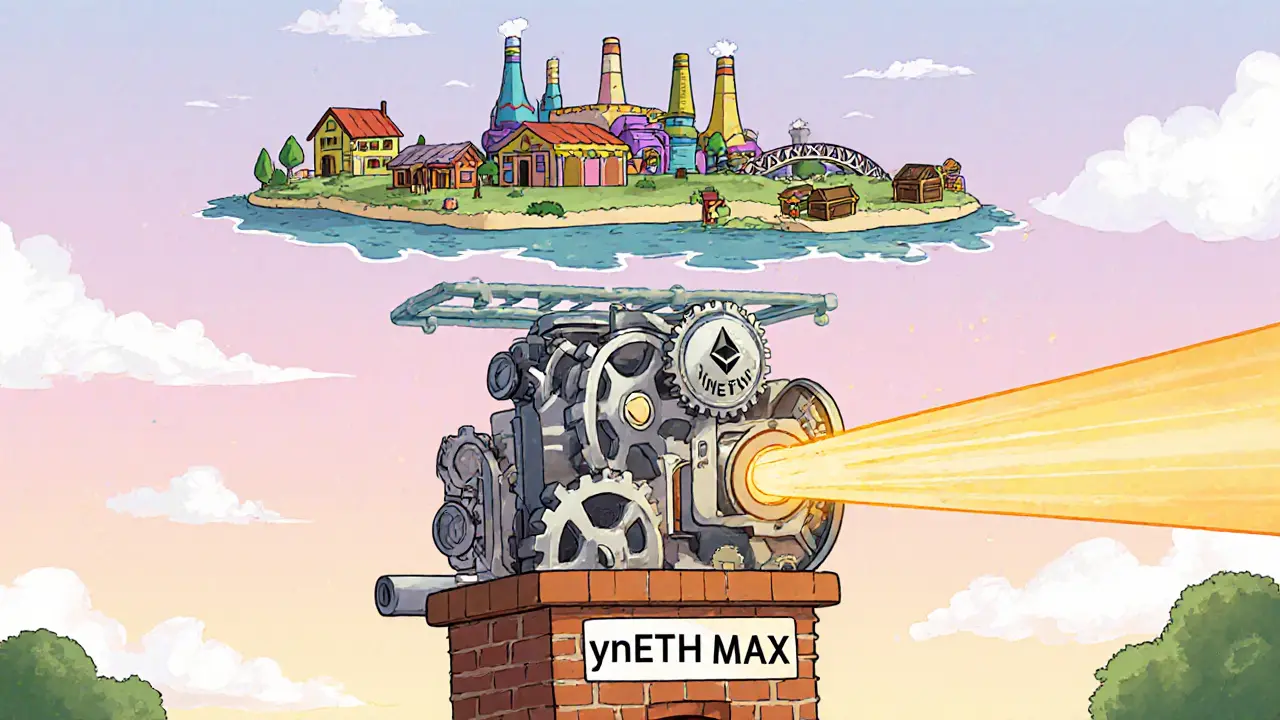ynETH MAX Yield Calculator
Enter your investment amount and time period to see projected returns.
How This Calculation Works:
ynETHx generates yield through three layers:
- 4-5% from Ethereum staking
- 3-6% from EigenLayer restaking
- Additional yield from cross-chain DeFi strategies
This calculator shows a conservative estimate of 10-15% risk-adjusted APY based on the article's description.
Quick Takeaways
- ynETH MAX (tickerynETHx) is a Liquid Restaking Token (MAXLRT) that blends ETH staking, EigenLayer restaking, and multi‑chain DeFi strategies.
- YieldNest Finance’s DAO manages the token’s modular yield engine, targeting a 10‑15% risk‑adjusted APY.
- Supply data shows a total supply of 1ynETHx with effectively zero circulating supply, creating an exclusive distribution model.
- Price volatility is high; 30‑day gains have exceeded 70% while daily moves can swing 1% or more.
- Key risks include smart‑contract bugs, EigenLayer slashing, and exposure to multiple DeFi protocols.
What is ynETH MAX (ynETHx)?
ynETH MAX is a Liquid Restaking Token built on the Ethereum blockchain. It belongs to a new class of assets called MAXLRT (Maximum Liquid Restaking Tokens). The token’s smart contract lives at address 0x657d...fc96dcb and is issued by YieldNest Finance, a decentralized autonomous organization (DAO) that focuses on extracting yield from Ethereum‑based assets.
Unlike traditional liquid staking tokens that only reflect ETH2.0 staking rewards, ynETHx adds two extra layers: restaking on EigenLayer and active deployment of capital into high‑yield DeFi farms across multiple chains. The result is a single‑ticket instrument that promises higher returns while keeping the security guarantees of Ethereum’s Layer1 settlement.
How does ynETH MAX generate yield?
The protocol’s yield engine is modular, meaning the DAO can turn strategies on or off without redeploying the main contract. At its core, three revenue streams feed the token’s APY:
- ETH staking rewards - The base layer locks ETH in the Ethereum consensus layer, earning the standard 4‑5% annual reward.
- EigenLayer restaking - Restaked ETH is delegated to EigenLayer, unlocking additional rewards from services that purchase security guarantees. This can add another 3‑6% depending on market demand.
- Cross‑chain DeFi strategies - Capital is allocated to farms on Optimism, Arbitrum, and other L2s where liquidity mining, lending, and trading fees generate extra yield. These strategies are rebalanced weekly to chase the highest risk‑adjusted returns.
The DAO’s sub‑DAOs vote on which strategies stay active, what weight each receives, and when to rebalance. This governance model aims to keep the overall annual percentage yield (APY) in the 10‑15% range, which is higher than most single‑strategy liquid staking tokens.

Tokenomics and supply quirks
ynETH MAX’s tokenomics look unusual at first glance. Data from Bitget reports a total supply of 1ynETHx and a circulating supply of 0ynETHx, resulting in a market cap of $0but a fully‑diluted cap of roughly $3,857. The design reflects an ultra‑exclusive issuance model: each ynETHx represents a claim on a large pool of ETH, EigenLayer positions, and DeFi assets. In practice, the token is minted only when a user deposits a pre‑defined amount of ETH into the YieldNest vault, and the minted token is locked until the user chooses to withdraw.
Because the supply is effectively “one token per vault”, the circulating figure appears as zero on many trackers. Exchanges list the token for trading, but each listed unit corresponds to an underlying vault contract rather than a fungible supply.
Market performance snapshot (Oct2025)
Price action across major exchanges shows strong upside with noticeable volatility:
- Bitget price: $3,851.08
- Bitrue price: $3,934.21 (5.21% weekly gain, 0.57% daily gain)
- MEXC daily change: -0.82% ($38.05 drop)
Longer‑term moves are impressive: +24.96% over 30days, +71.39% over 60days, and +67.25% over 90days. Volume remains modest, reflecting the token’s niche audience of institutional and advanced retail investors.
Risks and considerations
High yield comes with layered risk:
- Smart‑contract risk - Three separate codebases (YieldNest vault, EigenLayer restaking module, and various DeFi farms) mean more attack surface.
- Restaking slashing - EigenLayer can slash staked ETH if a downstream service misbehaves, potentially reducing the underlying collateral.
- Cross‑chain exposure - Deploying capital on L2s subjects investors to bridge failures, L2 bugs, and differing security models.
- Governance risk - DAO decisions may favor certain strategies over others, creating conflict‑of‑interest scenarios.
- Regulatory uncertainty - Complex DeFi products are under increased scrutiny worldwide; future rules could limit restaking or yield‑farming activities.
Potential investors should audit the contract code, read YieldNest’s governance proposals, and consider diversifying away from a single token that bundles many strategies.
How to acquire and store ynETHx
ynETHx is listed on several exchanges, including Bitget, Bitrue, and MEXC. The typical acquisition flow is:
- Sign up on a supported exchange and complete KYC if required.
- Deposit ETH into the exchange’s wallet.
- Navigate to the trading pair (e.g., ETH/ynETHx) and place a market or limit order.
- Withdraw the received ynETHx to a non‑custodial wallet that supports custom ERC‑20 tokens (e.g., MetaMask, Trust Wallet).
- To claim the underlying yield, interact with the YieldNest portal and either keep the token locked or redeem for the underlying assets.
Because the token represents a vault position, moving it off‑exchange does not automatically claim the yield; you must still interact with the smart contract to trigger withdrawals.

Comparison with other liquid staking solutions
| Feature | ynETH MAX (ynETHx) | stETH (Lido) | Lido‑USDC |
|---|---|---|---|
| Underlying protocol | Ethereum + EigenLayer + Multi‑chain DeFi | Ethereum staking only | Ethereum staking + USDC yield farm |
| Target APY | 10‑15% (risk‑adjusted) | 4‑5% | 6‑9% |
| Supply model | 1 token per vault (effectively non‑fungible) | Fully fungible, billions minted | Fully fungible |
| Governance | YieldNest DAO (multiple sub‑DAOs) | Lido DAO (staking‑only focus) | Lido DAO + USDC protocol governance |
| Risk profile | High (smart‑contract + restaking + cross‑chain) | Medium (single smart contract) | Medium‑high (USDC exposure) |
| Liquidity | Listed on niche exchanges, limited retail liquidity | High liquidity on major DEXes | High liquidity |
The table shows why ynETHx appeals to yield‑hungry investors willing to accept extra complexity, while stETH remains the go‑to choice for users who simply want a liquid ETH stake.
Frequently Asked Questions
Frequently Asked Questions
What does the "MAX" in ynETH MAX stand for?
MAX refers to the "Maximum Liquid Restaking Token" class. It signals that the token aims to capture the maximum possible yield by stacking multiple restaking and DeFi strategies under one ERC‑20 wrapper.
How is ynETHx different from regular liquid staking tokens like stETH?
While stETH only reflects ETH2.0 staking rewards, ynETHx adds EigenLayer restaking and active DeFi deployments. This multi‑layer approach targets a higher APY but also brings additional smart‑contract and cross‑chain risks.
Can I unstake my ETH directly from ynETHx?
No. ynETHx represents a locked vault position. To retrieve the underlying ETH you must interact with the YieldNest contract, withdraw the vault, and then claim the returned assets. This process can incur gas fees and a short waiting period.
Is there a risk of slashing from EigenLayer?
Yes. EigenLayer can slash restaked ETH if a downstream service misbehaves. The slashing would affect the portion of the vault allocated to restaking, reducing the overall yield.
Where can I buy ynETHx?
ynETHx trades on Bitget, Bitrue, and MEXC. After purchase, you can move the token to any ERC‑20 compatible wallet for storage.
Next steps for interested investors
If you’re intrigued by the yield potential, start by reviewing YieldNest’s public GitHub repos and reading the latest DAO proposals. Test the protocol with a small deposit, monitor the APY, and assess the gas costs of withdrawing. Over time, you can adjust your exposure by re‑balancing between ynETHx and simpler options like stETH, matching your risk tolerance.


Comments
gayle Smith
Yo, the ynETH MAX token is basically the apex of liquid restaking, a hyper‑layered conduit that marries Ethereum staking yields with EigenLayer's restake infrastructure. It’s not just a token, it’s a dynamic liquidity primitive that lets you pivot between staking and DeFi strategies on the fly. Think of it as a colossus of composable finance, where each layer compounds the next, delivering a risk‑adjusted APY that’s screaming for arbitrageurs. The whole ecosystem is powered by a multi‑chain orchestration engine that syncs validator rewards with cross‑chain yield farms.
October 13, 2025 AT 02:05